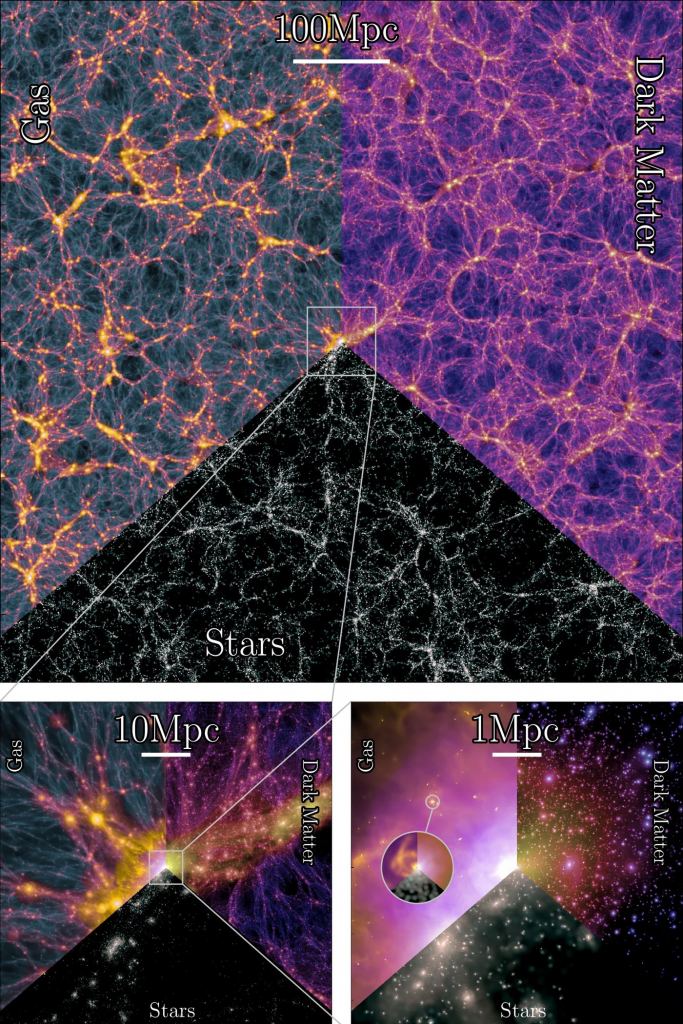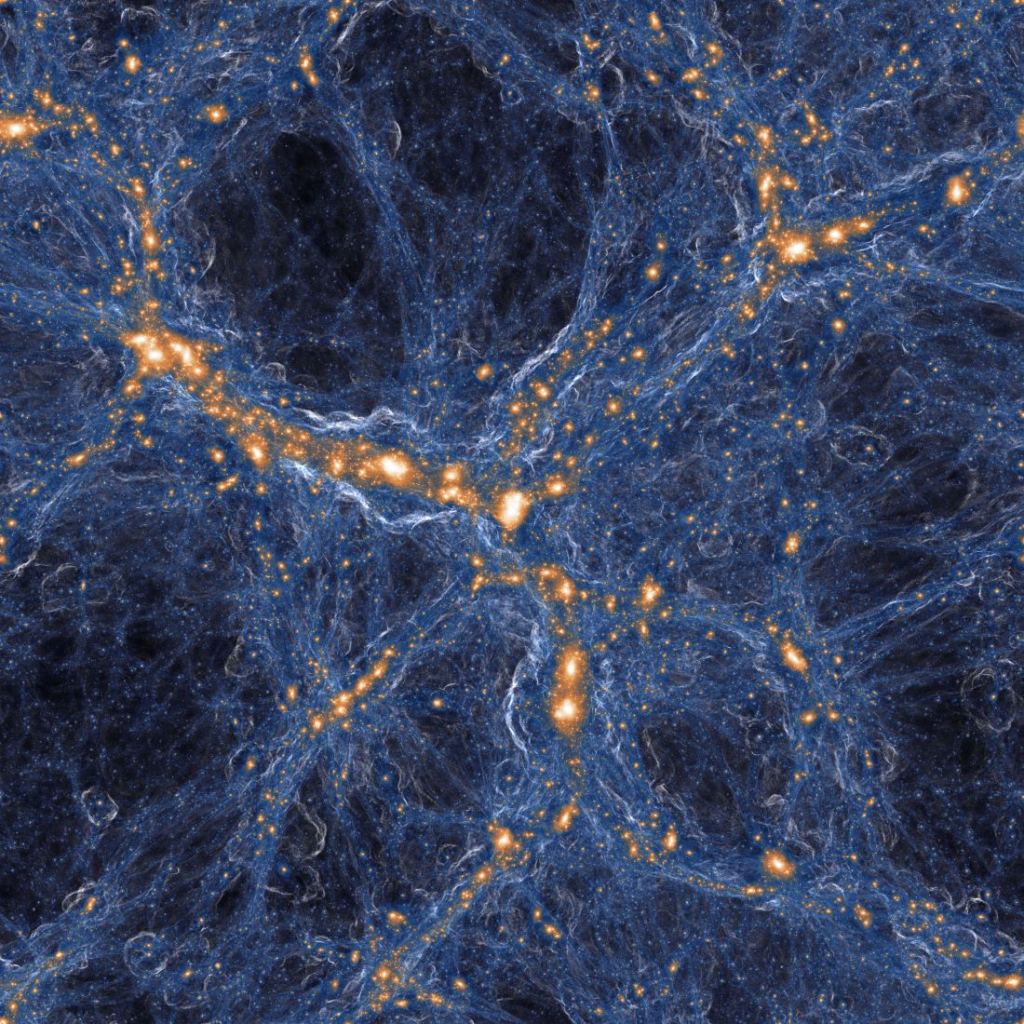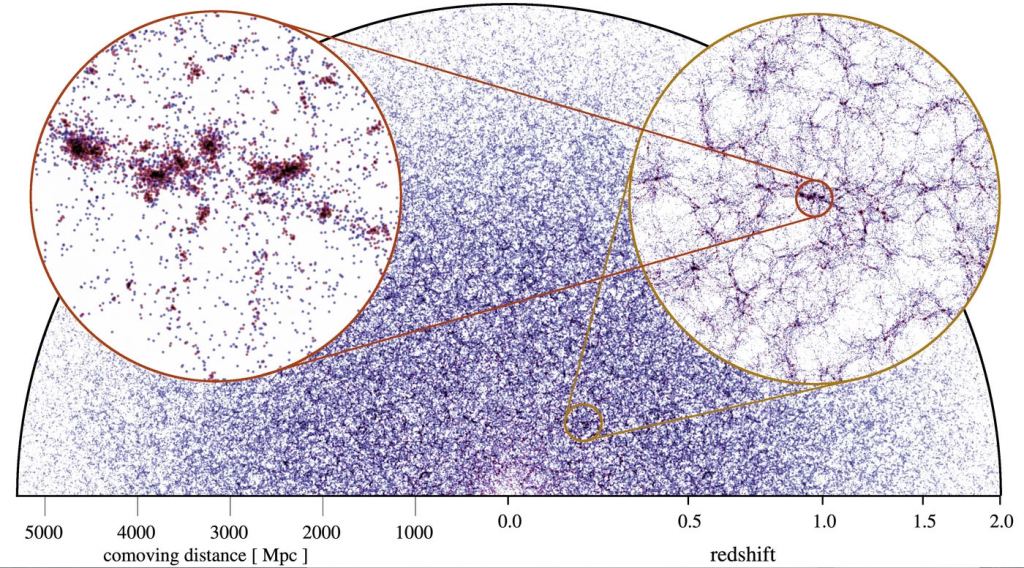There's an old joke among astronomy students about a question on the final exam for a cosmology class. It goes like this: "Describe the Universe and give three examples." Well, a team of researchers in Germany, the U.S., and the UK took a giant leap toward giving at least one accurate example of the Universe.
To do it, they used a set of simulations called "MillenniumTNG". It traces the buildup of galaxies and cosmic structure across time. It also provides new insight into the standard cosmological model of the Universe. It's the latest in cosmological simulations, joining such ambitious efforts as the AbacusSummit project of a couple of years ago.
This simulation project takes into account as many aspects of cosmic evolution as possible. It uses simulations of regular (baryonic) matter (which is what we see in the Universe). It also includes dark matter, neutrinos, and the still-mysterious dark energy on the formation mechanisms of the Universe. That's a tall order.
Simulating the Universe
More than 120,000 computer cores in the SuperMUC-NG in Germany went to work on the data for MillenniumTNG. That tracked the formation of about a hundred million galaxies in an area of space about 2,400 million light-years across. Then the Cosma8 at Durham went to work computing a larger volume of the Universe but filled with a trillion simulated dark matter particles and another 10 billion that tracked the action of massive neutrinos.
The result of this number crunching was a simulated area of the Universe that mirrored the formation and distribution of galaxies. The size was big enough that cosmologists can use it to extrapolate assumptions about the entire Universe and its history. They can also use it to probe for "cracks" in the Standard Cosmological Model of the Universe.
The Cosmological Model and Prediction
Cosmologists have this basic model they propose to explain the evolution of the Universe. It goes like this: The Universe has different types of matter. There's ordinary baryonic matter, which is what all of us and the stars, planets, and galaxies are made of. It's just under 5% of the "stuff" of the cosmos. The rest is dark matter and dark energy.
The cosmology community calls this strange set of cosmic circumstances the "Lambda Cold Dark Matter" model (LCDM, for short). It actually describes the Universe pretty well. However, there are some discrepancies. Those are what the simulations should help solve. The model is based on data from a huge variety of sources, including cosmic microwave radiation to the "cosmic web", where galaxies are arranged along an intricate network of dark matter filaments.
What's still missing is a good understanding of exactly what dark matter is. And, as for dark energy, well, it's a challenge. And, astrophysicists and cosmologies are looking for a better understanding of LCDM and the existence of the two big unknowns. That requires a lot of sensitive new observations from astronomers. On the other side of the coin, it also needs more detailed predictions for what the LCDM model actually implies. It's a huge challenge and is what's driving the big MillenniumTNG simulations. If cosmologists can successfully simulate the Universe then they can use those simulations to help understand what's happening "in real life." That includes characteristics of galaxies both in the modern Universe and in very early epochs.
Understanding and Predicting Galaxy Orientations in the Universe using MillenniumTNG
The MillenniumTNG simulations follow prior simulation projects called "Millennium" and "IllustrisTNG". This most recent set gives a tool to clear up some gaps in their understanding of such things as galaxy evolution and their shapes (or morphology).
Astronomers have long known about something called "intrinsic galaxy alignments." This is basically a tendency for galaxies to orient their shapes in similar directions, for reasons that no one quite understands.
It turns out that weak gravitational lensing affects how we see galaxy alignment. The MillenniumTNG simulations could allow astronomers to measure such alignments in the "real world" using its simulated alignments. That's a big step forward, according to team member Ana Maria Delgado. "Perhaps our determination of the intrinsic alignment of galaxy orientations can help to resolve the current discrepancy between the amplitude of matter clustering inferred from weak lensing and from the cosmic microwave background," she said.
Probing the Past
As with other areas of cosmology, the MillenniumTNG group is probing the very young Universe through simulations. This is a time after the Epoch of Reionization when the first stars were already shining and the first galaxies evolved. Some of those early galaxies are quite large, which seems a little out of context with an infant Universe. The James Webb Space Telescope (JWST) has seen them and the question remains: how did they get so massive in such a short time after the Big Bang?
MillenniumTNG simulations actually seem to replicate this tendency for some early galaxies to grow large in a short time. Typically, this is about 500 million years after the Big Bang. So, why are these galaxies so massive? Astronomer Rahul Kannan suggests a couple of ideas to explain that. "Perhaps star formation is much more efficient shortly after the Big Bang than at later times, or maybe massive stars are formed in higher proportions back then, making these galaxies unusually bright", he explained.
Now that JWST is probing even earlier times in cosmic history, it will be interesting to see if the simulations predict what it finds. Kennan suggests that there could well be disagreement between the real universe and simulations. If that happens, it will hand cosmologists yet another puzzling question about the earliest epochs of cosmic history.
The Future of Simulated and Real Universe Exploration
The next decades of cosmological studies will benefit heavily from simulations such as Millennium TNG. However, simulations are only as good as the data they receive and the assumptions their science teams make. The MillenniumTNG is benefitting from vast databases of information, plus the abilities of supercomputers to crunch their data. According to the team's principal investigator, Professor Volker Springel at Max Planck Institute, the simulations that produced more than 3 petabytes of data are a major asset to cosmology.
"MillenniumTNG combines recent advances in simulating galaxy formation with the field of cosmic large-scale structure, allowing an improved theoretical modeling of the connection of galaxies to the dark matter backbone of the Universe," he said. "This may well prove instrumental for progress on key questions in cosmology, such as how the mass of neutrinos can be best constrained with large-scale structure data."
Certainly his predictions square with the goals of the MillenniumTNG project. The teams continue to build on the success of the IllustrisTNG project, which did hydrodynamical simulations as well as the dark-matter-only Millennium simulation created nearly a decade ago. The team's simulations have been used to study a number of different galaxy topics. They include clustering of matter and galaxy halos, galaxy clusters and distribution, galaxy formation models, galaxy populations in the early universe, those intrinsic alignments of galaxies, and other related topics. While they may not yet be able to define the Universe completely (and give three examples) the MillenniumTNG team is taking huge steps in understanding its origin and evolution.
For More Information
Looking for Cracks in the Standard Cosmological Model
MillenniumTNG Project Web Page
 Universe Today
Universe Today



